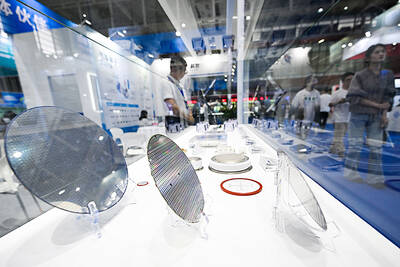Taiwan High Speed Rail Corp (THSRC, 台灣高鐵) celebrated its second year of operation last week, reporting that the company has doubled annual ridership from the 1.55 million in 2007 to 3.06 million last year after its service inception on Jan. 5, 2007.
Cumulative passenger numbers have reached 4.65 million, which translates to an average of two THSRC trips per person, the company said over the weekend.
At the same time, the company also announced annual sales of NT$23 billion (US$640 million) last year, a 70 percent increase from NT$13.5 billion the year before.
Taiwan High Speed Rail has operated a total of 70,915 trains in its two-year history, with an average punctuality rate of 99.15 percent.
Fifteen months into service, the company broke a ridership record of 23 million (on April 12 last year), and in another eight months, the number multiplied to 46 million (on Dec. 30), statistics released by the company said.
Despite these milestones, so far Taiwan High Speed Rail has failed to return NT$300 million in interest it owes the Ministry of Transportation and Communications (MOTC).
As part of the former government’s bailout plan for the financially strapped company, China Aviation Development Foundation (CADF), a semi-state organization under the supervision of MOTC, invested NT$4.5 billion in THSRC in 2005.
The Taipei-based company is forecast to become profitable sometime this year.
THSRC plans to set up a total of 12 stations along the western corridor.
Currently, eight stations are in service, while Nankang (南港), Miaoli (苗栗), Changhua (彰化) and Yuanlin (雲林) stations are estimated to begin service next year.
During the Lunar New Year holiday, the railway company is rolling out a special schedule from Jan. 22 until Feb. 2. Starting last Wednesday, passengers have been able to reserve tickets for travel in the holiday period online, via a phone reservation system or in person at THSRC ticket booths nationwide.
To cut down on crowding in the trains during the holiday’s high-traffic period, only assigned seating will be provided. Train cars nine through 12, which is normally a free-seating section, will be assigned seating only for the duration.
The THSRC corporate Web site provides up-to-the-minute time tables and fare prices.
In other news, the high-speed rail network, which runs along the west coast of Taiwan, emits a quarter of carbon dioxide emissions per inividual than regular four-wheeled vehicles emit, THSRC said.
Moreover, in its two years of operation, the company said it has effectively relieved the nation of 745,551 tonnes of harmful chemical compounds, which is equivalent to planting 3,976 Taiwania cryptomerioides (台灣杉), making it an environmentally-friendly mode of transportation.
Taiwania cryptomerioides is an indigenous conifer discovered and named by Japanese botanist Dr. Bunzo Hayata (早田文藏) in 1906, when the country was under Japanese occupation.

Taiwan’s exports soared 56 percent year-on-year to an all-time high of US$64.05 billion last month, propelled by surging global demand for artificial intelligence (AI), high-performance computing and cloud service infrastructure, the Ministry of Finance said yesterday. Department of Statistics Director-General Beatrice Tsai (蔡美娜) called the figure an unexpected upside surprise, citing a wave of technology orders from overseas customers alongside the usual year-end shopping season for technology products. Growth is likely to remain strong this month, she said, projecting a 40 percent to 45 percent expansion on an annual basis. The outperformance could prompt the Directorate-General of Budget, Accounting and

The demise of the coal industry left the US’ Appalachian region in tatters, with lost jobs, spoiled water and countless kilometers of abandoned underground mines. Now entrepreneurs are eyeing the rural region with ambitious visions to rebuild its economy by converting old mines into solar power systems and data centers that could help fuel the increasing power demands of the artificial intelligence (AI) boom. One such project is underway by a non-profit team calling itself Energy DELTA (Discovery, Education, Learning and Technology Accelerator) Lab, which is looking to develop energy sources on about 26,305 hectares of old coal land in

Netflix on Friday faced fierce criticism over its blockbuster deal to acquire Warner Bros Discovery. The streaming giant is already viewed as a pariah in some Hollywood circles, largely due to its reluctance to release content in theaters and its disruption of traditional industry practices. As Netflix emerged as the likely winning bidder for Warner Bros — the studio behind Casablanca, the Harry Potter movies and Friends — Hollywood’s elite launched an aggressive campaign against the acquisition. Titanic director James Cameron called the buyout a “disaster,” while a group of prominent producers are lobbying US Congress to oppose the deal,

Two Chinese chipmakers are attracting strong retail investor demand, buoyed by industry peer Moore Threads Technology Co’s (摩爾線程) stellar debut. The retail portion of MetaX Integrated Circuits (Shanghai) Co’s (上海沐曦) upcoming initial public offering (IPO) was 2,986 times oversubscribed on Friday, according to a filing. Meanwhile, Beijing Onmicro Electronics Co (北京昂瑞微), which makes radio frequency chips, was 2,899 times oversubscribed on Friday, its filing showed. The bids coincided with Moore Threads’ trading debut, which surged 425 percent on Friday after raising 8 billion yuan (US$1.13 billion) on bets that the company could emerge as a viable local competitor to Nvidia